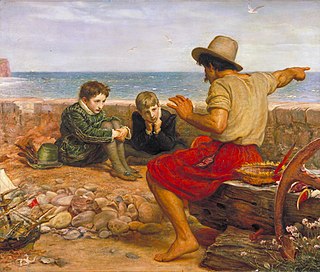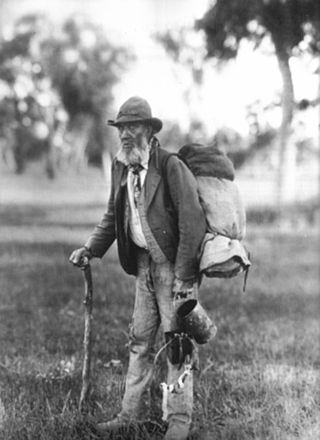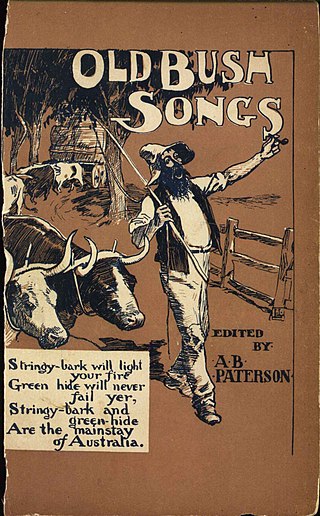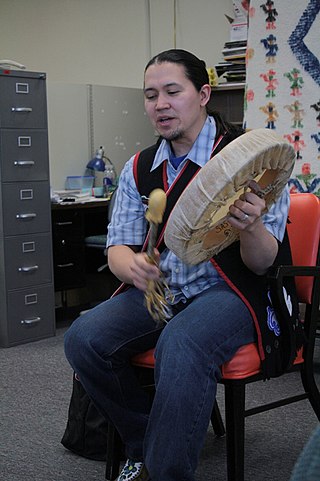
Storytelling is the social and cultural activity of sharing stories, sometimes with improvisation, theatrics or embellishment. Every culture has its own stories or narratives, which are shared as a means of entertainment, education, cultural preservation or instilling moral values. Crucial elements of stories and storytelling include plot, characters and narrative point of view. The term "storytelling" can refer specifically to oral storytelling but also broadly to techniques used in other media to unfold or disclose the narrative of a story.

A swagman was a transient labourer who travelled by foot from farm to farm carrying his belongings in a swag. The term originated in Australia in the 19th century and was later used in New Zealand.

Melanesian Meriam people are an Indigenous Australian group of Torres Strait Islander people who are united by a common language, strong ties of kinship and live as skilled hunter–fisher–gatherers in family groups or clans on a number of inner eastern Torres Strait Islands including Mer or Murray Island, Ugar or Stephen Island and Erub or Darnley Island. The Meriam people are perhaps best known for their involvement in the High Court of Australia's Mabo decision which fundamentally changed land law in Australia - recognising native title.

Carcoar is a small town in the Central West region of New South Wales, Australia, in Blayney Shire. In 2016, the town had a population of 200 people. It is situated just off the Mid-Western Highway 258 km west of Sydney and 52 km south-west of Bathurst and is 720 m above sea level. It is located in a small green valley, with the township and buildings on both banks of the Belubula River. It is the third oldest settlement west of the Blue Mountains. Carcoar is a Gundungurra word meaning either 'frog' or 'kookaburra'. Nearby towns are Blayney, Millthorpe, Mandurama, Neville, Lyndhurst and Barry
The Speewah is a mythical Australian station that is the subject of many tall tales told by Australian bushmen. The stories of the Speewah are Australian folktales in the oral tradition. The Speewah is synonymous with hyperbole as many of the tales about the place are used to enhance the storytellers' masculinity by relating events of extreme hardship and overcoming the dangers of the Australian wilderness.

Australian folklore refers to the folklore and urban legends that have evolved in Australia from Aboriginal Australian myths to colonial and contemporary folklore including people, places and events, that have played part in shaping the culture, image and traditions that are seen in contemporary Old Australia.
Ceremonial dancing has a very important place in the Indigenous cultures of Australia. They vary from place to place, but most ceremonies combine dance, song, rituals and often elaborate body decorations and costumes. The different body paintings indicate the type of ceremony being performed. They play an important role in marriage ceremonies, in the education of Indigenous children, as well as storytelling and oral history. The term corroboree is commonly used to refer to Australian Aboriginal dances, although this term has its origins among the people of the Sydney region. In some places, Aboriginal people perform corroborees for tourists. In the latter part of the 20th century the influence of Indigenous Australian dance traditions has been seen with the development of concert dance, with the Aboriginal Centre for the Performing Arts (ACPA) providing training in contemporary dance.

John Donahue, also spelled Donohoe, and known as Jack Donahue and Bold Jack Donahue, was an Irish-born bushranger in Australia between 1825 and 1830. He became part of the notorious "Wild Colonial Boys".
Biblical storytelling is more than just “telling the story.” It is a discipline in which the storyteller takes a passage from the Bible, studies and reflects on that passage, and then tells it in a way so that the hearers may best connect with the story as well.

Aboriginal trackers were enlisted by Europeans in the years following British colonisation of Australia, to assist them in exploring the Australian landscape. The excellent tracking skills of these Aboriginal Australians were advantageous to settlers in finding food and water and locating missing persons, capturing bushrangers and dispersing other groups of Indigenous peoples.

The bush ballad, bush song, or bush poem is a style of poetry and folk music that depicts the life, character and scenery of the Australian bush. The typical bush ballad employs a straightforward rhyme structure to narrate a story, often one of action and adventure, and uses language that is colourful, colloquial, and idiomatically Australian. Bush ballads range in tone from humorous to melancholic, and many explore themes of Australian folklore, including bushranging, droving, droughts, floods, life on the frontier, and relations between Indigenous and non-Indigenous Australians.

Oral storytelling is an ancient and intimate tradition between the storyteller and their audience. The storyteller and the listeners are physically close, often seated together in a circular fashion. The intimacy and connection is deepened by the flexibility of oral storytelling which allows the tale to be moulded according to the needs of the audience and the location or environment of the telling. Listeners also experience the urgency of a creative process taking place in their presence and they experience the empowerment of being a part of that creative process. Storytelling creates a personal bond with the teller and the audience.

Australian folk music is the traditional music from the large variety of immigrant cultures and those of the original Australian inhabitants.

Hugh Morgan Hill who performed as Brother Blue, was an American educator, storyteller, actor, musician, and street performer based principally in the Boston area. After serving as First Lieutenant from 1943 to 1946 in the segregated United States Army in World War II and being honorably discharged, he received a BA from Harvard College in 1948, was accepted into the Harvard Graduate School of Arts and Sciences (GSAS) before transferring to receive a MFA from the Yale School of Drama and a Ph.D. from the Union Institute, having delivered his doctoral presentation at Boston's Deer Island Prison, accompanied by a 25-piece jazz orchestra, with a video recording for his dissertation committee's further consideration. While performing frequently at U.S. National Storytelling Festivals and flown abroad by organizations and patrons from England to Russia and the Bahamas, Brother Blue regularly performed on the streets around Cambridge, most notably in Harvard Square. He was the Official Storyteller of Boston and of Cambridge by resolutions of both city councils.
Stephen Muecke BA, Mes.L (Paris), PhD (UWA) FAHA is Emeritus Professor of Ethnography at the University of New South Wales, Australia and Adjunct Professor at the Nulungu Institute, University of Notre Dame, Broome. He studied linguistics and semiotics, completing his PhD on storytelling techniques among Aboriginal people in Broome, Western Australia.

Alaska Native storytelling has been passed down through generations by means of oral presentation. The stories tell life lessons or serve as lessons in heritage. Many different aspects of Arctic life are incorporated into each story, mainly the various animals found in Alaska. Due to the decline in the number of speakers of native languages in Alaska and a change in lifestyle amongst many of the native peoples, oral storytelling has become less common. In recent years many of these stories have been written down, though many people argue that the telling of the story is just as important as the words within.
Martha Ansara is a documentary filmmaker whose films on social issues have won international prizes and been screened in Australia, the UK, Europe and North America. Ansara was one of the first women in Australia to work as a cinematographer, is a full member of the Australian Cinematographers Society (ACS) and was inducted into the ACS Hall of Fame in 2015. Martha is a Life Member of the Australian Directors Guild and a founding member of Ozdox, the Australian Documentary Forum. She has also worked as a film lecturer and film writer and has been active in the trade union, women's and peace movements.
The history of Chinese after those from the British Isles. Significant Chinese emigration only began in earnest after the discovery of gold and the subsequent gold rushes in Australia. This migration shaped and influenced Australian policies on immigration for over a century. Despite facing societal discrimination and restrictive immigration policies, Australians of Chinese descent have
Indigenous peoples of Canada are culturally diverse. Each group has its own literature, language and culture. The term "Indigenous literature" therefore can be misleading. As writer Jeannette Armstrong states in one interview, "I would stay away from the idea of "Native" literature, there is no such thing. There is Mohawk literature, there is Okanagan literature, but there is no generic Native in Canada".
Siobhán McHugh is an Irish-Australian author, podcast producer and critic, oral historian, audio documentary-maker and journalism academic. In 2013 she founded RadioDoc Review, the first journal of critical analysis of crafted audio storytelling podcasts and features, for which she received an academic research award. She is Associate Professor of Journalism (honorary) at the University of Wollongong (UOW). and Associate Professor of Media and Communications (honorary) at the University of Sydney. Her latest book, The Power of Podcasting: telling stories through sound, was published by NewSouth Books in February 2022. A US edition with Columbia University Press is due October 2022.
1. Nell Bell & June Barnes,(1999) "Australian Storytelling": Australian Folklore, No 14.
2. John S Ryan (1981) Australian Fantasy and Folklore









